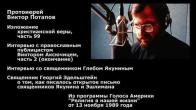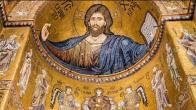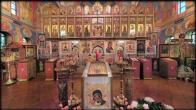You are here
St. Macarius of Alexandria
19 January / 1 February
 The Saint was born in the year 295 in Alexandria. He was a merchant until the age of 40, when he received Holy Baptism and went off into the desert. After several years of ascetic life he was ordained a presbyter and appointed prior of a monastery known as the “Kellii,” or “cells” in the Egyptian desert, between the Nitria mountain and a skete in which monastic hermits lived in silence, each in his own cell. He was the truest friend of Venerable Macarius of Egypt (+ ca. 390-394), and together with him was exiled from his homeland during the reign of Valens. The two Macariuses were very much alike in character and manner of life, and shared a single instructor and director — Venerable St. Anthony the Great (+ 356), who repeatedly instructed them in how to perfect themselves by living a virtuous life.
The Saint was born in the year 295 in Alexandria. He was a merchant until the age of 40, when he received Holy Baptism and went off into the desert. After several years of ascetic life he was ordained a presbyter and appointed prior of a monastery known as the “Kellii,” or “cells” in the Egyptian desert, between the Nitria mountain and a skete in which monastic hermits lived in silence, each in his own cell. He was the truest friend of Venerable Macarius of Egypt (+ ca. 390-394), and together with him was exiled from his homeland during the reign of Valens. The two Macariuses were very much alike in character and manner of life, and shared a single instructor and director — Venerable St. Anthony the Great (+ 356), who repeatedly instructed them in how to perfect themselves by living a virtuous life.
It so happened that Venerable Sts. Macarius of Alexandria and Macarius of Egypt had to cross the river Nile in a large ferryboat; also crossing on it were two tribunes, together with their splendid retinue of military attendants – weapons-bearers and bodyguards, adorned with gold braid and gold belts. When those tribunes noticed the two venerable elders, wearing old clothing, and standing in the corner, they praised their humble life of poverty: One of the tribunes said to the elders, “You are blessed in being scorned by the world.” In response, Venerable Macarius of Alexandria said, “Truly, we are scorned by the world, but the world laughs at you. What you said was not of your own volition; it was prophetic: we are both named “Macarius,” [a word] which means ‘blessed’.” Upon returning home, the tribune, deeply moved by Macarius of Alexandria’s words, cast off his clothing, gave his possessions to the poor, and chose the life of a hermit.
Intensifying his spiritual struggle, Venerable St. Macarius made it his rule not to eat any bread or pottage, except for coarse millet or some other grain soaked in water. For seven years, he maintained that kind of abstinence. Then for three years he would eat but a small piece of bread (less than a pound) per day, with an equal measure of water; greatly mortifying his flesh. Marshalling all his resources, the Venerable One also fought to avoid sleeping, but after such a spiritual struggle would instruct others “To the extent that I could, I overcame sleep, but it was not within my power to overcome human nature, which requires sleep, and so I had to show it obedience.”
To overcome the demon of lust that had begun to severely tempt him, St. Macarius sat naked for six months in a swamp at the skete, allowing himself to be bitten by a multitude of large mosquitoes. When he returned to his cell, it was only by his voice that the others could recognize him as Abba Macarius.
Having learned of the extremely strict rule for monastic life observed at the Tabbenesiot Monastery, whose prior was Venerable St. Pachomios the Great (+ 348), St. Macarius disguised himself in secular clothing, and over the course of the entire Quadragesima [the 40-day Great Lent] neither ate bread nor drank water. He would eat only a few cabbage leaves on Sundays, and he even did that only so that the other monks might see him eat, and so that he would not fall into the sin of haughty arrogance. Venerable St. Macarius worked throughout the night, without stopping to rest, or ever sitting or lying down. He would stand with his mouth shut, not speaking with anyone, keeping silent, and with his whole heart raising up prayers to God. Witnessing the Saint’s spiritual struggle, the other monastic strugglers were ashamed, for they had become conceited, taking pride in their spiritual struggle and fasting. Having demonstrated humility and taught a lesson to all, St. Macarius returned to his place.
The enemy of the human race from time immemorial was greatly embittered by St. Macarius’ strictly ascetic way of life. Thus, he began to tempt the Saint with vanity, pressing him to go to Rome. Battling that temptation, the Saint filled a sandbag, took it on his shoulders, and, carrying that burden, for a long time walked about the desert until his body had become exhausted and the prideful idea had left him.
Through his ascetic way of life, fasting, and rejection of everything earthly, Venerable St. Macarius acquired the gift of working miracles and seeing people’s hidden thoughts. He was made worthy to have many miraculous visions. Filled with Divine grace, Abba Macarius saw that demons were present during liturgical chanting and during monastic assemblies. He witnessed them mock some by bringing them somnolence or [inappropriate] thoughts. Sitting on the necks and shoulders of other brethren, those among the weakest, those inattentive in prayer, they maliciously mocked and jeered them. However, as soon as the demons would start to do something inappropriate before certain monks, they would immediately be driven off by some kind of force, and would no longer dare to either stop in front of, or even pass by those monks.
Venerable St. Macarius told of something else even more marvelous and frightening: how Venerable Mark, one of the ascetics of the Holy Monastery, was taking Communion from the hands of the Angels, and how careless monks were receiving not the Body of Christ, but burning coals, while the Body of Christ offered by the hand of the priest would return to the Altar. The demons would flee far away from those worthy of receiving Holy Communion. Meanwhile, the Angel of the Lord stood with the priest near the Altar, and extended his hand alongside that of the priest to distribute the Divine Mysteries.
St. Macarius gained renown for a multitude of miraculous healings of the sick, and healings of those possessed by demons.
After many labors and spiritual struggles, Venerable St. Macarius departed in peace to the Lord in ca. 394-395, at the age of 100 years.
St. Macarius was a religious writer, whose works include his “Homily On the Departure of the Soul” (incorporated in the Great Psalter), as well as a 30-chapter Monastic Rule, and an epistle addressed to monastics.
Relics in cathedral - monthly calendar
| S | M | T | W | T | F | S |
|---|---|---|---|---|---|---|
|
|
|
|
|
|
|
1
|
|
2
|
3
|
4
|
5
|
6
|
7
|
8
|
|
9
|
10
|
11
|
12
|
13
|
14
|
15
|
|
16
|
17
|
18
|
19
|
20
|
21
|
22
|
|
23
|
24
|
25
|
26
|
27
|
28
|
|
PARISH LIFE
Address of our Cathedral
While all the materials on this site are copyrighted, you may use them freely as long as you treat them
with respect and provide attribution on the Russian Orthodox Cathedral of St.John the Baptist of Washington DC.









